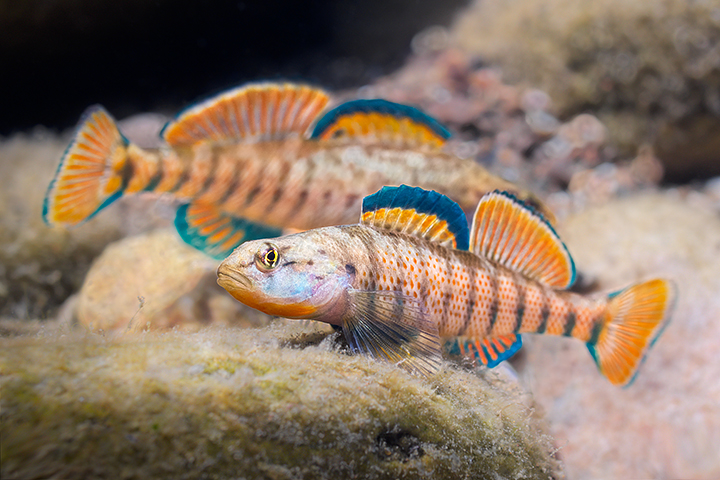Interactions
The rainbow darter, similar to numerous other
animals, lives every day in response and according to its
interactions with other species. Take for example, the
Ptychobranchus occidentalis and Venustaconcha pleasii, parasites
that attach to the gills of the darter and encapsulate
themselves in the host's tissue. These glochidia larvae of some
freshwater mussels cling onto the fish for a period of anywhere
from a few days to multiple weeks, or anytime after they develop
into free-living juveniles. These parasites often times increase
ventilation rates of the Etheostoma caeruleum species,
restricting their activity levels. In some cases, the darters
have lost body size and have showed significantly weaker
responses to predation risk (Crane et
al., 2011).

Additionally,
it is important to consider the interactions the rainbow darter
has with the human population, rather than just other parasitic
species. One study in particular was performed in a stream by
snorkeling biologists in order to determine the fish's responses
to chemical alarm cues. They exposed the species to skin
extracts that served as cues, and in the presence of the alarms,
the rainbow darters showed a significantly higher amount of
latency to move. This experiment and interaction between the
Etheostoma caeruleum and humans indicates that the fish can
sense alarming signs and respond with the appropriate behaviour
like, in this case, freezing and resisting movement (Crane,
Mathis, and Woods, 2009). Although considered an experiment,
this is actually a beneficial interaction since it provides
scientists with information in regards to the rainbow darter
species and how it would respond in similar situations.
Another study
was performed on the rainbow darters, however in this case, to
collect information that would pertain and help in the
understanding of another species of fish, the yellowcheek dater,
also known as Etheostoma moorei. Since this fish is extremely
endangered, biologists did not want to test their hypotheses in
fear of harming them more, so instead they used the rainbow
darters, a fish which is surprisingly abundant in population.
This surrogate species assisted in proving the hypotheses
correct, therefore allowing scientists to work with the
yellowcheek darter without fear of harming the fish (Johnson
and Weston, 2008).
Ultimately,
the rainbow darter has and will continue to prove itself useful
in both human interactions as well as illustrating relationships
between itself and other species. Much information can be sought
out and obtained by analyzing this type of data and conducting
similar experiments.
Next, learn many new facts about the
rainbow darter, or return to the home page.